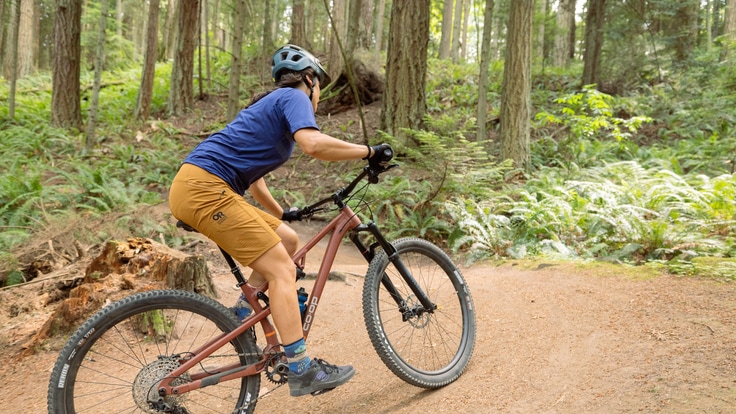Mountain bikes are sophisticated machines that turn dust, duff, roots and rocks into grin-inducing fun. Their performance technology involves geometric angles, bump-softening shocks, varying wheel sizes and a host of components for shifting, braking and even adjusting the saddle height while pedaling. It's enough to boggle even bike geeks.
So we asked our team of experts to winnow the options and help you find the right one for you. These mountain bikes serve different types of cyclists, from newbies who are just developing a relationship with mountain biking to experienced cyclists who hammer singletrack seven days a week. Some models serve riders who need one bike for multiple aims—including bikepacking or commuting. All are sold at REI Co-op, where bike techs are trained to answer questions that these reviews can't address. They've helped scores of people to find their bliss on mountain bikes. Here's their short list of proven winners.
Staff Picks
For quick recommendations, check out our roundup below, or scroll down for more in-depth reviews.
- Best Mountain Bike for Flowy Trails: Rocky Mountain Element Alloy 30 Mountain Bike
- Best Value Mountain Bike: Co-op Cycles DRT 3.3 Mountain Bike
- Best Mountain Bike for Technical Trails: Rocky Mountain Altitude Alloy 50
- Best Electric Mountain Bike: Cannondale Moterra SL 2 Electric Mountain Bike
- Best All-Around Mountain Bike for Smaller Riders: Cannondale Habit 4 Mountain Bike
- Best Hardtail Mountain Bike: Salsa Timberjack SLX 29 Mountain Bike
Best Mountain Bike for Flowy Trails
Rocky Mountain Element Alloy 30 Mountain Bike
Wheel size 29 in.
Frame material FORM alloy
Suspension Full (130mm/front; 120mm/rear)
Drivetrain Shimano Deore; 10-51T; 12-speed
If you thrive on a fast, flowy singletrack (think banked turns, pumping rollers and smooth descents), the Rocky Mountain Element Alloy 30 is built to manage your energy. This responsive mountain bike offers the perfect balance between speed and control, making it a popular choice for riders who want to climb with ease and descend with confidence.
“The geometry of this bike is the perfect middle ground for a flow trail,” says Allison Williams, a buyer for bike clothing and accessories at REI. “A 130 mm trail bike is just what you need.” To customize your ride, the RIDE-4 adjustment system lets you dial in the geometry so you can better match the trail or your preferred riding style.
A steep seat tube angle keeps you centered on steep climbs, while the 29-inch wheels and 2.4-inch Maxxis tires let you roll fast and stay planted, even on loose corners. This full-suspension bike lets you do a little bit of everything without losing momentum.
With space for two water bottles, you’ll stay hydrated whether tackling short laps or dusty all-day trail adventures. Available in four sizes for riders 5’1” to 6’6.” Buy here.
Best Value Mountain Bike
Co-op Cycles DRT 3.3 Mountain Bike
Wheel size 27.5 in. (XS, S); 29 in. (M-XL)
Frame material Aluminum
Suspension Full (140mm/front; 130mm/rear)
Drivetrain Shimano SLX; 10-51; 12-speed
The DRT 3.3 from Co-op Cycles helps beginners feel confident while delivering the performance that experienced riders want when negotiating technical singletrack. Its approachable price also endears it to entry-level riders, and yet the build includes quality components that appeal to the full ability spectrum and make this model an incredible value.
"The four-piston brakes are very strong, ensuring controlling speed on the descent," says Robert Blazoff, a retail specialist in the Northville, Michigan, REI store. Two-piston models cost less but typically deliver less stopping power. Paired with large, 180mm Shimano rotors, the Shimano Deore disc brakes scrub excess speed in a jiffy. That reassures tentative riders, and the shorter stopping distance also helps experts maintain momentum. Smaller sizes incorporate 27.5-inch wheels, while larger riders get 29-inch hoops. Doing so optimizes the bike's weight and handling for the size of its intended rider. And at 2.4 inches wide, the Maxxis tires balance rolling efficiency with confidence-boosting traction. Says Blazoff, "It will provide grip even on the steepest root-filled rocky technical climb." Thus, the DRT 3.3 provides all-around performance at a great price. Buy here.
Best Mountain Bike for Technical Trails
Rocky Mountain Altitude Alloy 50 Mountain Bike
Wheel size 29 in.
Frame material FORM alloy
Suspension Full (170mm/front; 160mm/rear)
Drivetrain Shiman Deore; 10-51T; 12-speed
When the trail gets rough, the Rocky Mountain Altitude Alloy 50 delivers. Technical terrain – including chunky rock gardens, steep switchbacks and unruly descents – meets its match with this mountain bike that’s built for enduro riding and gnarly terrain.
“Its purpose-built to go fast and handle steep trails,” says Williams. “It’s going to eat up everything that you throw at it.” A full suspension bike, with 170mm of front travel and 160mm in the rear, the Altitude smooths out even the harshest terrain, so you can stay confident and composed.
The RIDE-4 adjustment system lets you tweak the geometry to match trail conditions, all with a single Allen key. It rolls on 29-inch wheels fitted with grippy 2.5-inch front and 2.4-inch back tires, offering superior traction and stability through technical corners, loose rocks and slick roots.
If your idea of a great ride involves a mix of speed, rowdy terrain and a little chaos, the Altitude Alloy 50 is up for the challenge. It comes in four sizes to fit riders from 5’1” to 6’6.” Buy here.
Best Electric Mountain Bike
Cannondale Moterra SL 2 Electric Mountain Bike
Wheel size 29 in. (front), 27.5 in. (rear)
Frame material Carbon fiber
Suspension Full (160mm/front; 150mm/rear)
Drivetrain Shimano Deore 6100; 10-51T; 12-speed
The Moterra SL 2 electric mountain bike from Cannondale is a lightweight, yet powerful electric mountain bike that excels on both technical climbs and fast, flowy descents. Weighing just over 45 lbs., it’s one of the lightest full-power e-MTBs out there—deftly balancing performance and ease.
Built with a lightweight carbon fiber frame, the Moterra SL2 houses a custom 601Wh battery that offers a 43-mile range with four levels of assist – from eco to turbo – so you can adjust power as needed during your ride. “You can go on longer rides endurance-wise, because you have the battery helping you,” says Williams.
Equipped with the Shimano EP801 motor, the bike provides smooth, responsive assistance, while the full suspension (160mm front, 150mm rear) absorbs bumps for a comfortable and controlled ride, even on rough, unpredictable terrain. Its mixed-wheel setup (29-inch front, 27.5-inch rear) lets you be both nimble and playful. The Flip Chip feature lets you convert to 29-inch wheels at both ends for enhanced traction and stability.
A versatile bike that can handle technical trails, long days and variable riding styles, the Moterra SL 2 makes it easier – and more fun – to tackle any trail you can find. Keep in mind, this bike does not come with pedals. Buy here.
Best Mountain Bike for Smaller Riders
Cannondale Habit 4 Mountain Bike
Wheel size 27.5 in. (XS); 29 in. (S-XL)
Frame material Aluminum
Suspension Full (140mm/front; 130mm/rear)
Drivetrain Shimano Deore; 11-51; 12-speed
This bike is not just for shorter people. Offered in sizes ranging from XS to XL, the Habit 4 represents excellent value in a mid-travel bike built for smooth-packed dirt and moderately technical trails. The Habit 4 from Cannondale accommodates the not-tall end of the size spectrum with an appealingly shorter reach (405mm in the XS), a low standover height (37.8 inches in the XS) and size-specific engineering. Instead of simply shrinking size Medium, Cannondale tweaks the geometry of each frame size so it performs best for the intended rider. Size-specific suspension kinematics further ensure that the smallest (and biggest) riders all enjoy optimal handling.
The setup also strives to balance uphill and downhill capability and results in a major fun factor on all parts of the trail. The 77.5-degree effective seat tube angle places the rider in a forward position that helps conquer climbs. The 65.5-degree head tube angle hits the sweet spot for ups and downs: It lets riders maintain control over the front wheel while gaining elevation and offers stability during descents. It's the jack-of-all trades trail bike that lets enthusiasts enjoy easy paths, ambitious singletrack, and bermed corners in lift-served bike parks. Buy here.
Best Hardtail Mountain Bike
Salsa Timberjack SLX 29 Mountain Bike
Wheel size 29 in.
Frame material Aluminum
Suspension Front (130mm)
Drivetrain Shimano Deore/SLX; 11-51; 12-speed
This is no bike-path build. The Timberjack SLX 29 from Salsa uses a long, low and slack geometry that delivers stability through rough trail features. The front end features a 66-degree head tube angle to soak up big roots and rocks. That, combined with the 130mm front fork and the larger wheels' ability to create a smooth ride over lumpy singletrack, helps this hardtail conquer technical routes.
It pairs the long wheelbase with short chainstays (420mm to 437mm) that keep the handling from feeling sluggish. The design feels snappy in turns and makes this bike a wheelie machine: The rigid frame lets riders execute bunny-hops and manuals with less effort.
At 33 pounds, it's not the lightest hardtail available (its weight is comparable to many mid-travel full-suspension bikes) but it's less expensive—without sacrificing quality components. The Shimano drivetrain and MT brakes promise excellent durability and low-fuss maintenance. And because the frame includes Salsa's alternator dropout, riders can customize the geometry to adapt to their needs: You can lengthen the chainstays to improve stability at high speeds or while bikepacking, or achieve enough chain tension to turn the rig into a single-speed. Buy here.
Mountain Bike Buying Advice
Figuring out the best mountain bike for you starts with where you plan to ride. After that, get in touch with your inner gear nerd by delving into componentry, specs and features. Lastly, figure out the right frame size. Learn more in our in-depth buying guide, How to Choose a Mountain Bike.
Bike Category
The ever-evolving world of bike categories can seem daunting, but it's worth the time to familiarize yourself with it before you select your ride. One key consideration is where and how you plan to ride. This will help determine the kind of mountain bike you should get. Just keep in mind that the lines between different bike subcategories can be blurry. And just because a bike is designed for a certain style of riding doesn't mean it can only be used in that way.
Trail bikes (nearly every bike in this article) are best for, you guessed it, trails. They're the most common style of mountain bike and designed for navigating rocks, roots, climbs, drops and everything that's fun about mountain biking. Cross-country bikes, on the other hand, are designed for mellower terrain (think: gravel roads), and more ups and downs. They're descended from a type of racing and tend to appeal to competitors and more skilled riders, as well as recreational riders who like to spin the pedals on dirt roads with undulating elevation profiles. All-mountain mountain bikes like the Rocky Mountain Altitude Alloy 50 are a breed of mountain bike designed for bigger leg-burning climbs, longer, more challenging descents and more technical features—both man-made and natural. Bikes for all-mountain riding are designed to perform well on steep descents while also being light and nimble enough to pedal uphill. Enduro bikes are a step up from all-mountain bikes, built specifically for the roughest descents and technical terrain. With a more aggressive geometry and longer suspension travel, these bikes excel in gravity-fed races and challenging downhill runs, making them the choice for those seeking both thrills and performance on demanding trails. Lastly, electric mountain bikes like the Cannondale Moterra SL 2 allow riders to cover more terrain and pedal farther. Many styles of mountain bikes can be found as e-bikes that include battery-powered motors.
Features
The more you ride, the more you'll learn about yourself and your tastes. Before you get there, however, you can make an educated guess about what sort of suspension and wheel size are best for you.
In general, full-suspension mountain bikes like most of the bikes in our lineup offer better performance on more rugged trails. They're also more expensive. Hardtail mountain bikes like the Timberjack SLX 29 from Salsa, which have a suspension on the front only, cost less. That suspension on the front can provide enough shock absorption and comfort for less rough trails. Plus, having no suspension in the rear means you won't lose pedaling power on climbs. Other suspension details matter, too, so take a peek at our article on suspension basics to learn more.
As for wheels, these days you typically have two choices: 27.5 inches or 29 inches. Smaller, 27.5-inch wheels are better at accelerating and maneuvering, while 29-inch wheels roll over obstacles easier and have better traction. Because frame geometry and wheel size are related, this decision also has implications in the bike size you choose. Learn more about wheel size here.
Frame Size
Getting the right fit starts with getting the right frame size. At its simplest, that requires checking the particular bike's sizing chart and choosing the cell that matches your height. It might also mean, though, that you need to determine your "standover" height (pant inseam length is a close approximation), and then pick a bike size that works with that geometry spec. Frame geometry – which encompasses factors like seat tube length, reach, standover height and seat height – may have implications in the bike size you choose.
Read Mountain Bike Fitting Basics to learn more.
Related articles:
Methodology
REI's bike techs have a lot of opinions when it comes to pairing riders and rides, so we polled them: What are the best mountain bikes at REI? We asked them for their favorite full-suspensions and hardtails, as well as value picks and bikes for newer riders. The rigs on this list are their favorites for most folks.
Editor's note 4/14/2025: Updated to add three new bikes, including the Rocky Mountain Element Alloy 30, Rocky Mountain Altitude Alloy 50 and Cannondale Moterra SL 2; updated buying advice to reflect these additions and to include information on enduro bikes and frame geometry; added a "related articles" section.































